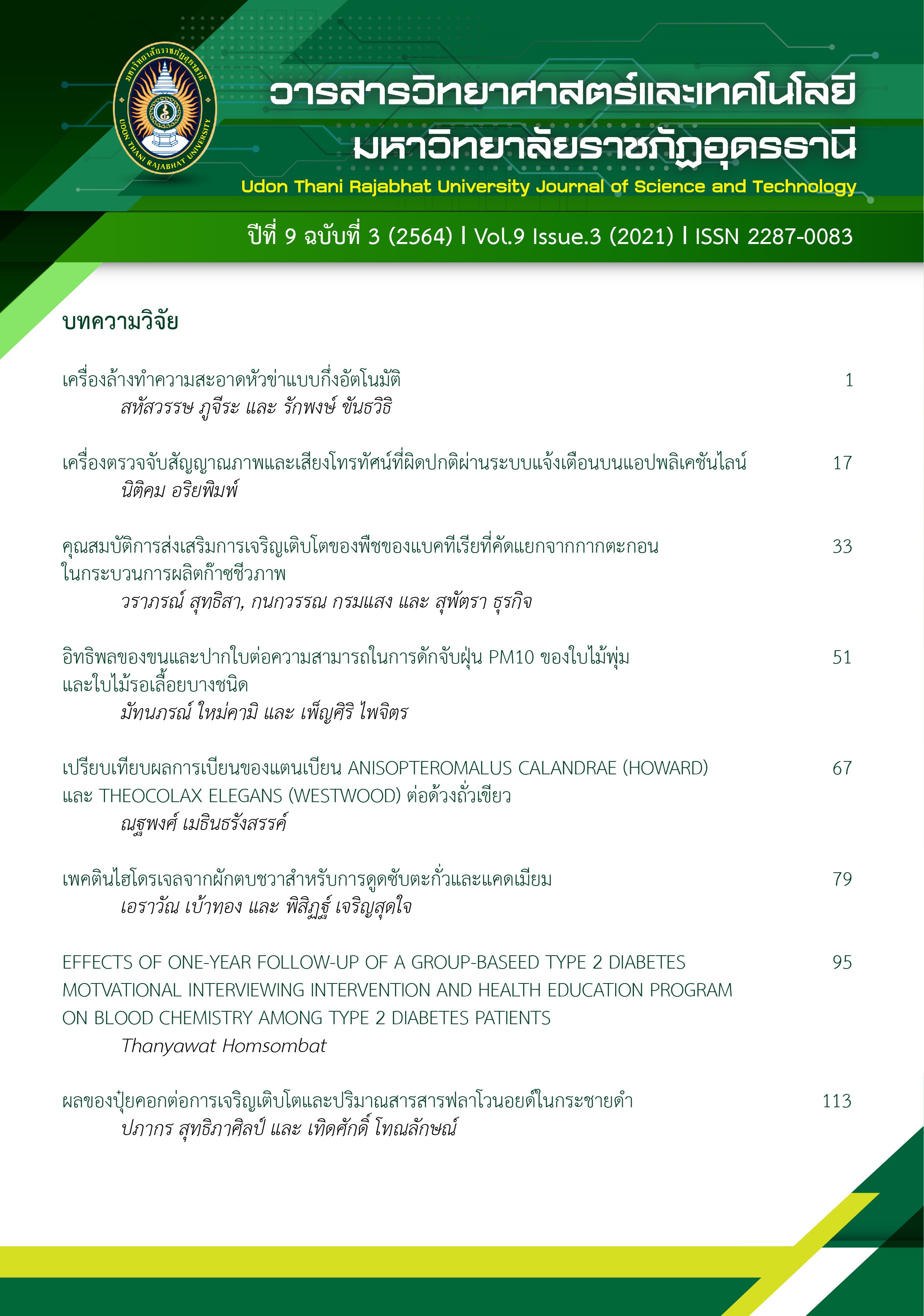COMPARISON THE EFFECTS OF PARASITISM OF ANISOPTEROMALUS CALANDRAE (HOWARD) AND THEOCOLAX ELEGANS (WESTWOOD) TO BEAN WEEVIL
Main Article Content
Abstract
The mung bean storage problems were infestation and destruction by mung bean insect pests. Especially, the bean weevil, Callosobruchus maculatus (F.), was one of the major pests of mung bean in Thailand. The objective of this research was to compare the effect of parasitism of Anisopteromalus calandrae (Howard) and Theocolax elegans (Westwood) to the bean weevil. The experiments were arranged in a completely randomized design (CRD). The sex ratio of A. calandrae and T. elegans between male and female 5 pairs were leaved into glass vials containing 100 seeds of mung bean with the 4th larval instar of bean weevil in the seeds. The treatments were replicated five times. After leaving for 24 hrs the A. calandrae and T. elegans were removed from the glass vials and was kept at temperature (25-27°C) with Relative Humidity (RH) at (75-80%). The research found that the A. calandrae had the parasitism higher than the T. elegans at the 4th larval instar of bean weevil. The percentage of parasitism and number of progenies of A. calandrae was 78.73% and 54.80 + 3.96 adults respectively, whereas the T. elegans was 57.19% and 33.40 + 3.61 adults, respectively. The sex ratio of male and female of the A. calandrae was 1:1.73 whereas the T. elegans was 1:1.38.
Article Details
References
ช่อลัดดา เที่ยงพุก. (2559). ถั่วเขียว: พืชทนแล้ง คุณค่าทางอาหารสูง. อาหาร, 46(4), 37–42.
สำนักงานคณะกรรมการพิเศษเพื่อประสานงาน โครงการอันเนื่องมาจากพระราชดำริ. (2553). คู่มือ การผลิตวุ้นเส้นจากถั่วเขียว. กรุงเทพฯ: หจก. อรุณการพิมพ์.
สำนักวิจัยและพัฒนาวิทยาการหลังการเก็บเกี่ยวและแปรรูปผลิตผลเกษตร. (2551). แมลงที่พบในผลิตผลเกษตรและการป้องกันกำจัด. พิมพ์ครั้งที่ 2. กรุงเทพฯ: โรงพิมพ์ชุมนุมสหกรณ์การเกษตรแห่งประเทศไทย จำกัด.
Bodlah, I., Bodlah, M. A., Naeem, M., Khaliq, S., & Aihetasham, A. (2016). First record of anisopteromalus calandrae (Howard, 1881) (Hymenoptera: Chalcidoidea: Pteromalidae) as a potential bio-control agent of stored grain beans from Rawalpindi and Islamabad. Asian Journal of Agriculture and Biology, 4(3), 73–76.
Brühl, C. A., & Zaller, J. G. (2019). Biodiversity decline as a consequence of an inappropriate environmental risk assessment of pesticides. Frontiers in Environmental Science, 7, Doi: 10.3389/fenvs.2019.00177.
Dey, K. R., Choudhury, P., & Dutta, B. K. (2013). Impact of pesticide use on the health of farmers: A study in Barak valley, Assam (India). Journal of Environmental Chemistry and Ecotoxicology, 5(10), 269–277.
Dlamini, B. E., & Amornsak, W. (2014). Effect of host age on progeny production of Theocolax elegans (Westwood) (Hymenoptera: Pteromalidae) reared on Sitophilus zeamais (Motschulsky) (Coleoptera: Curculionidae). Kasetsart Journal Natural Science, 48, 587–597.
Ji, J., Choi, W., & Ryoo, M. (2004). Fitness and sex allocation of Anisopteromalus calandrae (Hymenoptera: Pteromalidae): relative fitness of large females and males in a multi-patch system. Annals of the Entomological Society of America, 97(4), 825–830.
Kole, R. K., Roy, K., Panja, B. N., Sankarganesh, E., Mandal, T., & Worede, R. E. (2019). Use of pesticides in agriculture and emergence of resistant pests. Indian Journal of Animal Health, 58(2) Special Issue, 53–70.
Mahal, N., Islam, W., Parween, S., & Mondal, K. A. M. S. H. (2005). Effect of Anisopteromalus calandrae (Hymenoptera: Pteromalidae) in controlling residual populations of Rhyzopertha dominica (Coleoptera: Bostrichidae) in wheat stores. International Journal of Tropical Insect Science, 25(4), 245–250.
Moosavi, M., Zandi-Sohani, N., & Rajabpour, A. (2021). Olfactory responses of the parasitoid wasp, Anisopteromalus calandrae (Hymenoptera: Pteromalidae) to odors from hosts and stored grain. Journal of Plant Protection Research, 61(2), 189–194.
Ngamo, T. S. L., Kouninki, H., Ladang, Y. D., Ngassoum, M. B., Mapongmestsem, P. M., & Hance T. (2007). Potential of Anisopteromalus calandrae (Hymenoptera: Pteromalidae) as biocontrol agent of Callosobruchus maculatus (F.) (Coleopetera: Bruchidae). African Journal of Agricultural Research, 2(4), 168–172.
Sitthichaiyakul, S., Kengkanpanich, R., Noochanapai, P., & Amornsak, W. (2018). Host-age preference of Theocolax elegans (Westwood) (Hymenoptera: Pteromalidae), a larval parasitoid of the lesser grain borer, Rhyzopertha dominica (Fabricius) (Coleoptera: Bostrichidae) and the cowpea weevil, Callosobruchus maculatus (Fabricius) (Coleoptera: Chrysomelidae). In: Proceedings of the 12th International Working Conference on Stored Product Protection (IWCSPP). October 7–11, Berlin, Germany.
Tsegaye, Z., Assefa, F., Tefera, G., Alemu, T., Gizaw, B., & Abatenh, E. (2018). Concept, principle and application of biological control and their role in sustainable plant diseases management strategies. International Journal of Research Studies in Biosciences (IJRSB), 6(4), 18–34.


